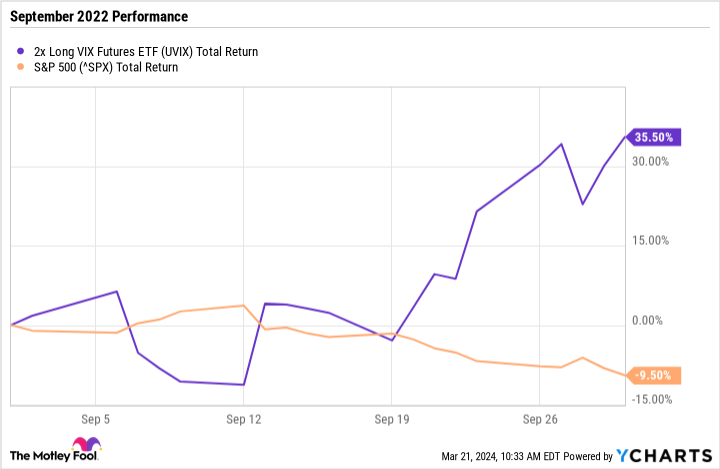Rattlesnakes. Poison dart frogs. A hornet's nest.
These are all things I'd rather not touch. Similarly, some exchange-traded funds (ETFs) are simply too risky for my taste. Here's one that I'd rather avoid.

Image source: Getty Images.
An ETF to avoid?
The 2x Long Vix Futures ETF (UVIX -1.12%) is a volatility ETF that tracks the Chicago Board Options Exchange volatility index using double leverage.
There's a lot to unpack there, so let's take this in steps.
First, what is volatility?
How volatility works
Imagine a stock currently trades for $100. Let's also imagine that, on average, its price goes up or down by $1 each day.
Next, let's imagine a second hypothetical stock, also trading for $100. But its price goes up or down by $20 each day.
In this example, stock two's price is swinging wildly from day to day, while stock one's price is far more stable. Therefore, we could say stock two is more volatile than stock one.
So, in a nutshell, volatility measures how much prices vary from day to day. This principle can also be applied to the stock market as a whole. When prices on the stock market change little from day to day, volatility is low. When prices start to swing wildly, though -- particularly to the downside -- stock market volatility skyrockets.
One measure of stock market volatility, the VIX -- also known as "the fear index" -- estimates the future 30-day volatility of the S&P 500 index using stock option prices.
And the VIX is the underlying index that the UVIX ETF is based on.
What about the 2x leverage?
Charlie Munger used to say there were only three ways for a smart person to go broke: "liquor, ladies, and leverage."
In the case of the UVIX ETF, the fund employs a leveraged strategy to double the return of the VIX daily. However, to maintain that exposure, the fund must invest in, then roll, one- and two-month futures contracts. This is all quite costly, and adds up to large investor charges.
For example, the UVIX has an expense ratio of 1.77%. That means that a $10,000 investment, held for one year, would generate $177 in annual fees. That's one of the highest expense ratios you'll find, and it's far higher than the average expense ratio of around 0.57%.
In short, the UVIX's use of 2x leverage and its high expense ratio is another reason to steer clear of this ETF as a long-term investment.
Why would anyone invest in this ETF?
Granted, UVIX is not an index to buy and hold. Simply look at what would have happened if you had invested $10,000 in it back in 2022:
That said, there is a reason why someone would invest money in the fund: It absolutely skyrockets when the market takes a nosedive.
Compare its performance in September 2022 to that of the S&P 500:
UVIX Total Return Level data by YCharts
The S&P 500 went down almost 10% that month; the UVIX gained more than 35%.
In short, some traders like to use UVIX as a hedge, as it generates big returns when the stock market plummets. However, while this can work in the short term, it simply doesn't work in the long term, because of the nature of volatility and the large fees charged by the fund.
For that reason, long-term investors should steer clear of this ETF.


